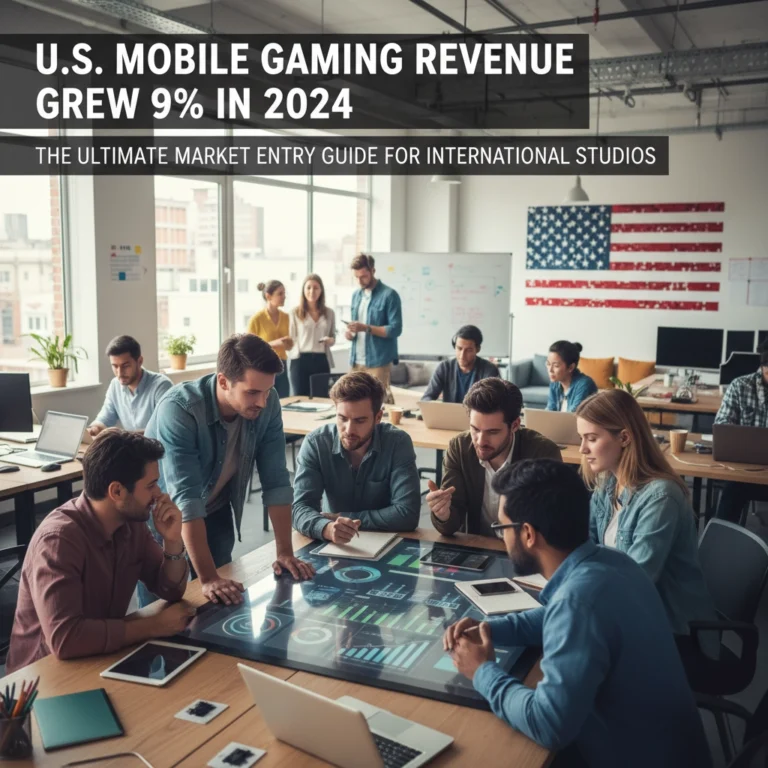Why Breaking Into the U.S. Mobile Gaming Market in 2025 Is Harder Than Ever (And How International Studios Can Win)

The New Reality of U.S. Mobile Gaming
The U.S. mobile gaming market is the world’s crown jewel—boasting $52 billion in annual consumer spending and more players than ever. But for international studios looking to break in, it’s never looked tougher. The competition is fierce. Budgets are sky-high. Players have more choices. And the playbook for success keeps getting rewritten, thanks to privacy changes, new monetization models, and shifting regulations.
So, what exactly is making it so hard for international studios to launch, grow, and actually succeed in the U.S. in 2025? And—more importantly—what strategies are working right now for overseas teams who want a real shot at landing in the winner’s circle?
Let’s break it down.
Why the U.S. Market Is Hard to Crack in 2025
1. User Attention: A Crowded Fight for Eyeballs
It’s noisy out there. With over 300,000 advertisers expected to compete for user attention this year, getting your game seen (let alone downloaded) is an Olympic-level feat. Even established studios are feeling the pinch as CPIs (cost-per-install) climb and organic reach gets squeezed by the sheer volume of competition.

- Paid user acquisition is more expensive than ever.
- Organic discoverability keeps dropping as storefronts overflow.
- Big brands with deep pockets dominate the top-grossing charts.
2. The Privacy-First Marketing Puzzle
Remember the golden days of micro-targeting your ideal user with hyper-specific ads? In the privacy-first era, that’s ancient history.
- Apple’s App Tracking Transparency (ATT) and Android’s privacy tweaks mean less visibility into user behavior.
- Lookalike audiences and hyper-targeted UA campaigns have lost their edge.
- Marketing teams must now build broader creatives and smarter funnels—without most of the “old” data they relied on.
3. Skyrocketing Production Costs
Gone are the days when a lean team and a good idea were all it took. Today:
- Top U.S. mobile games require multi-million dollar budgets, massive art and engineering teams, and ongoing live ops support.
- The bar for graphics, UX, and gameplay depth continues to rise.
- Even outstanding indie games risk invisibility without big spend on marketing and retention.
4. Regulatory Hurdles and Cultural Complexity
Want to stay compliant in the U.S.? Get ready for:
- Different regulations in nearly every state around loot boxes, IAPs, and data collection.
- New government scrutiny on advertising to children and responsible monetization.
- An ever-evolving patchwork—what passes in California may not fly in Texas or New York.
Market Growing in Spite of Challenges
Here’s the crazy part: the market’s getting tougher to enter, but the prize is getting bigger.
- Sessions are up 12% in 2025 compared to last year.
- Revenue from in-app purchases has finally started growing again, rising 4%.
- Players are spending 8% more time in-game.
- Mobile gaming worldwide is projected to hit $166 billion—and could double over the next half-decade.
Translation? Opportunity is booming… if you can make it through the gauntlet.

How International Studios Can Win in 2025
Let’s get practical. Here are the playbook moves we’re seeing pay off for international studios breaking into the U.S., right now.
1. Master Hybrid Monetization (or Bust)
If you’re relying on old-school ads or just IAPs, you’re missing out. The most successful studios now blend:
- In-app purchases (IAPs) for whale power and mid-spender conversion
- Ads for broader reach, but with a greater focus on rewarded and interactive formats
- Subscriptions for reliable, recurring revenue streams
Diversifying monetization isn’t just smart; it’s essential. Done right, hybrid monetization can balance volatility in ad markets and drive longer-term LTV—especially as users jump between games faster than ever.
2. Turbocharge with AI-Driven Marketing
The AI revolution in mobile gaming isn’t hype—it’s giving nimble studios a legit edge.
- AI-powered creative generation means studios can rapidly test hundreds of ad variations to find what clicks with U.S. players.
- Smarter UA with predictive analytics helps optimize spend, especially as old targeting tools get sunset.
- Automated testing accelerates go-to-market and helps smaller teams punch above their weight.

If you’re not deep-diving into AI-driven workflows, you’re competing with one hand tied behind your back.
3. Think Beyond Mobile: Cross-Platform Expansion
Why limit yourself to a single device when U.S. players are just as happy to play on PC and console?
- Dovetail your mobile launch with plans for Steam, Epic, or console releases.
- Consider “companion apps” or cross-progression as hooks to keep players engaged everywhere.
- Build brand loyalty by meeting players where they’re most comfortable—don’t force the platform.
This approach is especially effective for genres that reward deeper engagement or social play, like strategy, RPGs, or shooters.
4. Lean into the Hybrid-Casual Boom
2025’s rising stars? Hybrid-casual games. These titles combine the stickiness of strategy and RPG mechanics with the accessibility of casual games.
- They’re the new sweet spot for American players who want more than simple mechanics but less commitment than hardcore titles.
- International studios can stand out by finding unique spins or culturally attuned themes that resonate in the States.
5. Build for Retention with Live Ops
With user acquisition costs going up, the real game is retention. Leading studios are doubling down on:
- Events, updates, and in-game “moments” to keep players coming back
- Personalized content drops or offers, often powered by AI
- Community management that fosters long-term engagement (and advocacy)
If you’re not planning for live ops from day one, you’re planning to lose players faster and spend more to replace them.
Direct-to-Consumer: The Secret Monetization Edge
One of the boldest shifts in 2025? Studios bypassing the app stores.
- Direct-to-consumer (D2C) models, from custom storefronts to web-based billing, are letting companies keep up to 20% more revenue per transaction.
- Playtika’s $667 million off-platform experiment proved it’s possible at scale—and smaller studios are adapting fast.
- D2C also brings more direct insights into your players, which is crucial in a privacy-first world.
This move comes with its own regulatory headaches, but for those who can navigate them, it’s a game changer.

Quick Tips for International Studios Eyeing the U.S.
- Localize more than your language: Cultural touches, humor, and references matter. Americans spot “lazy localizations” a mile away.
- Build for scale, but stay scrappy: Nimble teams test faster and respond to U.S. trends quickly—don’t wait for 100% feature completeness to launch a soft test.
- Tap into the community: Influencers, small streamers, and Discord servers can be bigger launchpads than paid ads.
- Regulatory awareness is survival: Invest early in legal advice—don’t get burned on local interpretations of games-as-gambling or data privacy.
- Watch your analytics like a hawk: Success in the U.S. requires constant iteration. Every cohort, every region, every channel could perform wildly different.
Final Word: The Future Belongs to the Bold (and the Data-Driven)
Breaking into the U.S. mobile gaming space in 2025 isn’t for the faint of heart, but it’s 100% doable for studios willing to evolve.
- Combine robust hybrid monetization, cutting-edge AI tools, and ingenious player engagement.
- Plan to go cross-platform and don’t sleep on direct-to-consumer strategies.
- Most importantly, listen to your players, iterate fast, and never assume the U.S. market will behave like your home turf.
Ready to level up your next release? Keep these trends top of mind—and don’t be afraid to shake things up.
Want to see what’s working? Check out some top-performing games shaping the market right now at Systara Games.







